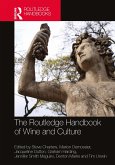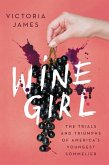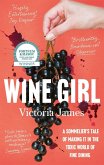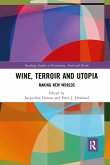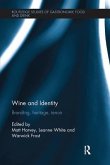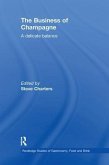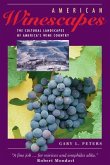The Routledge Handbook of Wine and Culture
Herausgeber: Charters, Steve; Dutton, Jacqueline; Demossier, Marion
The Routledge Handbook of Wine and Culture
Herausgeber: Charters, Steve; Dutton, Jacqueline; Demossier, Marion
- Broschiertes Buch
- Merkliste
- Auf die Merkliste
- Bewerten Bewerten
- Teilen
- Produkt teilen
- Produkterinnerung
- Produkterinnerung
The link between culture and wine reaches back into the earliest history of humanity. The Routledge Handbook of Wine and Culture brings together a newly comprehensive, interdisciplinary overview of contemporary research and thinking on how wine fits into the cultural frameworks of production and consumption.
Andere Kunden interessierten sich auch für
![The Routledge Handbook of Wine and Culture The Routledge Handbook of Wine and Culture]() The Routledge Handbook of Wine and Culture246,99 €
The Routledge Handbook of Wine and Culture246,99 €![Wine Girl Wine Girl]() Victoria JamesWine Girl23,99 €
Victoria JamesWine Girl23,99 €![Wine Girl Wine Girl]() Victoria JamesWine Girl16,99 €
Victoria JamesWine Girl16,99 €![Wine, Terroir and Utopia Wine, Terroir and Utopia]() Wine, Terroir and Utopia45,99 €
Wine, Terroir and Utopia45,99 €![Wine and Identity Wine and Identity]() Wine and Identity51,99 €
Wine and Identity51,99 €![The Business of Champagne The Business of Champagne]() The Business of Champagne61,99 €
The Business of Champagne61,99 €![American Winescapes American Winescapes]() Gary L PetersAmerican Winescapes49,99 €
Gary L PetersAmerican Winescapes49,99 €-
-
-
The link between culture and wine reaches back into the earliest history of humanity. The Routledge Handbook of Wine and Culture brings together a newly comprehensive, interdisciplinary overview of contemporary research and thinking on how wine fits into the cultural frameworks of production and consumption.
Produktdetails
- Produktdetails
- Verlag: Taylor & Francis Ltd
- Seitenzahl: 496
- Erscheinungstermin: 14. April 2025
- Englisch
- Abmessung: 246mm x 174mm x 27mm
- Gewicht: 858g
- ISBN-13: 9781032198071
- ISBN-10: 1032198079
- Artikelnr.: 73481816
- Herstellerkennzeichnung
- Libri GmbH
- Europaallee 1
- 36244 Bad Hersfeld
- gpsr@libri.de
- Verlag: Taylor & Francis Ltd
- Seitenzahl: 496
- Erscheinungstermin: 14. April 2025
- Englisch
- Abmessung: 246mm x 174mm x 27mm
- Gewicht: 858g
- ISBN-13: 9781032198071
- ISBN-10: 1032198079
- Artikelnr.: 73481816
- Herstellerkennzeichnung
- Libri GmbH
- Europaallee 1
- 36244 Bad Hersfeld
- gpsr@libri.de
Steve Charters is Professor of Wine Marketing and a researcher at Burgundy School of Business in Dijon, and is responsible for developing teaching and research programmes focusing on all aspects of the business, culture and history of wine. He is also adjunct professor in the Adelaide Business School at the University of Adelaide, Australia. Marion Demossier is Professor of Social Anthropology in the Department of Modern Languages and Linguistics at the University of Southampton. She has recently completed a monograph on the anthropology of wine and terroir: Burgundy, a Global Anthropology of Place and Taste. Jacqueline Dutton is Professor of French Studies at the University of Melbourne. She co-edited Wine, Terroir and Utopia: Making New Worlds (with Peter J. Howland) and her research focuses on the cultural history of wine in Bordeaux, Burgundy, and Champagne. Graham Harding is a wine historian attached to the history faculty of the University of Oxford. His Champagne in Britain, 1800-1914: How the English Transformed a French Luxury was published in 2021. Jennifer Smith Maguire is Professor of Cultural Production and Consumption at the Sheffield Business School, Sheffield Hallam University. Her expertise lies in the socio-cultural study of consumer culture and cultural intermediaries, with a special focus on the construction of markets, tastes and value. Denton Marks is Professor Emeritus of Economics at the University of Wisconsin-Whitewater and fellow of the American Association of Wine Economists. His research involves a range of aspects of wine as a cultural good, and his Wine and Economics: Transacting the Elixir of Life is used internationally in various oenological programs. Tim Unwin is Emeritus Professor of Geography at Royal Holloway, University of London. He co-founded the Journal of Wine Research in 1990 and was external examiner and academic advisor to the Institute of Masters of Wine from 2004 to 2011.
Introduction. Part I- Context: Disciplinary Perspectives On Wine And
Culture. 1Anthropology, Wine and Culture. 2.Business, Wine and Culture.
3.Economics, Wine and Culture. 4.Geography, Wine and Culture. 5.History,
Wine and Culture. 6.Sociology, Wine and Culture. 7.Text, Wine and Culture.
Part II- Production and Place. 8.Cultures of Terroir. 9.Sites and Sights of
Production: Spaces and Performances of Winemaking. 10.Wine Islands:
Colonial Cultures of the Vine. 11.Expressing Sense of Place and Terroir
through Wine to Tourism Encounters: Antipodal Reflections from France to
New Zealand. 12.Wine, Culture and Environment: A Study of the Sierra
(Nevada) Foothills American Viticultural Area. 13.Making Wine, Making Home.
14.Climats and the Crafting of Heritage Value in Burgundy Terroir. 15.Wine,
Deep in the Heart of Texas. Part III- Intermediation and Consumption.
16.Characters of Wine: The Cultural Meanings of Typefaces and Fonts in Wine
Labels. 17.Making the Right Impression: Irish Wine Culture c.1700 to
Present. 18.Wine as part of Polish Identity in Early Modern Times.
Constructing Wine Culture in Non-Wine Countries. 19.The Shape of Luxury:
Three Centuries of the Champagne Glass in British Material Culture. 20.'For
Us as Experimentalists': An Australian Case Study of Scientific Values in
the 19th Century New World Winegrowing. 21.Tasting as Expertise: Scientific
Agronomists and Sommeliers in France in the First Half of the Twentieth
Century. 22.Wine Writing as Lifestyle Writing: Communicating Taste and
Constructing Lifestyle in the Saturday Times Wine Column. 23.The
(Practical) Economics of Selling Wine as a Cultural Good. 24.Champagne: A
Global Symbol of Contemporary Consumer Culture. Part IV: Belief and
Representation. 25.Wine and Religion Part I: Antiquity to 1700. 26.Wine and
Religion Part II: 1700 to the Present. 27.Wine as Metaphor. 28.New world
wine and the evolution of universal, vernacular, metro-rural, and
indigenous idylls. 29.Narratives of Science and Culture in Winemaking.
30.Applying Fashion Theory to Wine: A Production of Culture Example.
31.Spending, Taste and Knowledge: Logics of Connoisseurship and Good Taste
in the Age of Cultural Democratisation. Part V: Power and Contestation.
32.Competing and Complementary Utopias: Toward an Understanding of
Entangled Wine Ideals. 33.Threats of Pleasure and Chaos: Wine and Gendered
Social Order. 34.Women in Wine...Occasionally: Gender Roles in the Wine
Industry. 35.Sustainable Wine: The Discursive Production of Sustainability
in the Wine Field. 36.The Triumph of the Holy Trinity: Terrior, Typicity,
and Quality Anchoring the AOC Model in the Second Half of the 20th Century.
37.What can Winemakers' business models tell us about the cultural traits
of wine regions? A Comparative analysis. 38.Repudiation Not Withstanding:
Critics and the Case for Hybrid Grape Wines. 39.If It's Famous, It Must Be
Good: The Social Construction of Brand Value in the US Wine Market. Part
VI: Change and the Future. 40.The Internationalization of Winegrape
Varieties and its Implication for Terroir-Based Cultural Assets.
41.Cultural Heritage and Migration in the Wine World. 42.The China Wine
Market: How Wine is Gaining Cultural Value in Chinese Culture. 43.Beyond
White: On Wine and Ethnicity. 44.Climate or Technical Change in Wine?
Confronting Climatologists' and Wine-Growers' Analyses. 45.Winegrowing,
Climate Change, and a Case for Biodynamic Viticulture. Conclusion
Culture. 1Anthropology, Wine and Culture. 2.Business, Wine and Culture.
3.Economics, Wine and Culture. 4.Geography, Wine and Culture. 5.History,
Wine and Culture. 6.Sociology, Wine and Culture. 7.Text, Wine and Culture.
Part II- Production and Place. 8.Cultures of Terroir. 9.Sites and Sights of
Production: Spaces and Performances of Winemaking. 10.Wine Islands:
Colonial Cultures of the Vine. 11.Expressing Sense of Place and Terroir
through Wine to Tourism Encounters: Antipodal Reflections from France to
New Zealand. 12.Wine, Culture and Environment: A Study of the Sierra
(Nevada) Foothills American Viticultural Area. 13.Making Wine, Making Home.
14.Climats and the Crafting of Heritage Value in Burgundy Terroir. 15.Wine,
Deep in the Heart of Texas. Part III- Intermediation and Consumption.
16.Characters of Wine: The Cultural Meanings of Typefaces and Fonts in Wine
Labels. 17.Making the Right Impression: Irish Wine Culture c.1700 to
Present. 18.Wine as part of Polish Identity in Early Modern Times.
Constructing Wine Culture in Non-Wine Countries. 19.The Shape of Luxury:
Three Centuries of the Champagne Glass in British Material Culture. 20.'For
Us as Experimentalists': An Australian Case Study of Scientific Values in
the 19th Century New World Winegrowing. 21.Tasting as Expertise: Scientific
Agronomists and Sommeliers in France in the First Half of the Twentieth
Century. 22.Wine Writing as Lifestyle Writing: Communicating Taste and
Constructing Lifestyle in the Saturday Times Wine Column. 23.The
(Practical) Economics of Selling Wine as a Cultural Good. 24.Champagne: A
Global Symbol of Contemporary Consumer Culture. Part IV: Belief and
Representation. 25.Wine and Religion Part I: Antiquity to 1700. 26.Wine and
Religion Part II: 1700 to the Present. 27.Wine as Metaphor. 28.New world
wine and the evolution of universal, vernacular, metro-rural, and
indigenous idylls. 29.Narratives of Science and Culture in Winemaking.
30.Applying Fashion Theory to Wine: A Production of Culture Example.
31.Spending, Taste and Knowledge: Logics of Connoisseurship and Good Taste
in the Age of Cultural Democratisation. Part V: Power and Contestation.
32.Competing and Complementary Utopias: Toward an Understanding of
Entangled Wine Ideals. 33.Threats of Pleasure and Chaos: Wine and Gendered
Social Order. 34.Women in Wine...Occasionally: Gender Roles in the Wine
Industry. 35.Sustainable Wine: The Discursive Production of Sustainability
in the Wine Field. 36.The Triumph of the Holy Trinity: Terrior, Typicity,
and Quality Anchoring the AOC Model in the Second Half of the 20th Century.
37.What can Winemakers' business models tell us about the cultural traits
of wine regions? A Comparative analysis. 38.Repudiation Not Withstanding:
Critics and the Case for Hybrid Grape Wines. 39.If It's Famous, It Must Be
Good: The Social Construction of Brand Value in the US Wine Market. Part
VI: Change and the Future. 40.The Internationalization of Winegrape
Varieties and its Implication for Terroir-Based Cultural Assets.
41.Cultural Heritage and Migration in the Wine World. 42.The China Wine
Market: How Wine is Gaining Cultural Value in Chinese Culture. 43.Beyond
White: On Wine and Ethnicity. 44.Climate or Technical Change in Wine?
Confronting Climatologists' and Wine-Growers' Analyses. 45.Winegrowing,
Climate Change, and a Case for Biodynamic Viticulture. Conclusion
Introduction. Part I- Context: Disciplinary Perspectives On Wine And
Culture. 1Anthropology, Wine and Culture. 2.Business, Wine and Culture.
3.Economics, Wine and Culture. 4.Geography, Wine and Culture. 5.History,
Wine and Culture. 6.Sociology, Wine and Culture. 7.Text, Wine and Culture.
Part II- Production and Place. 8.Cultures of Terroir. 9.Sites and Sights of
Production: Spaces and Performances of Winemaking. 10.Wine Islands:
Colonial Cultures of the Vine. 11.Expressing Sense of Place and Terroir
through Wine to Tourism Encounters: Antipodal Reflections from France to
New Zealand. 12.Wine, Culture and Environment: A Study of the Sierra
(Nevada) Foothills American Viticultural Area. 13.Making Wine, Making Home.
14.Climats and the Crafting of Heritage Value in Burgundy Terroir. 15.Wine,
Deep in the Heart of Texas. Part III- Intermediation and Consumption.
16.Characters of Wine: The Cultural Meanings of Typefaces and Fonts in Wine
Labels. 17.Making the Right Impression: Irish Wine Culture c.1700 to
Present. 18.Wine as part of Polish Identity in Early Modern Times.
Constructing Wine Culture in Non-Wine Countries. 19.The Shape of Luxury:
Three Centuries of the Champagne Glass in British Material Culture. 20.'For
Us as Experimentalists': An Australian Case Study of Scientific Values in
the 19th Century New World Winegrowing. 21.Tasting as Expertise: Scientific
Agronomists and Sommeliers in France in the First Half of the Twentieth
Century. 22.Wine Writing as Lifestyle Writing: Communicating Taste and
Constructing Lifestyle in the Saturday Times Wine Column. 23.The
(Practical) Economics of Selling Wine as a Cultural Good. 24.Champagne: A
Global Symbol of Contemporary Consumer Culture. Part IV: Belief and
Representation. 25.Wine and Religion Part I: Antiquity to 1700. 26.Wine and
Religion Part II: 1700 to the Present. 27.Wine as Metaphor. 28.New world
wine and the evolution of universal, vernacular, metro-rural, and
indigenous idylls. 29.Narratives of Science and Culture in Winemaking.
30.Applying Fashion Theory to Wine: A Production of Culture Example.
31.Spending, Taste and Knowledge: Logics of Connoisseurship and Good Taste
in the Age of Cultural Democratisation. Part V: Power and Contestation.
32.Competing and Complementary Utopias: Toward an Understanding of
Entangled Wine Ideals. 33.Threats of Pleasure and Chaos: Wine and Gendered
Social Order. 34.Women in Wine...Occasionally: Gender Roles in the Wine
Industry. 35.Sustainable Wine: The Discursive Production of Sustainability
in the Wine Field. 36.The Triumph of the Holy Trinity: Terrior, Typicity,
and Quality Anchoring the AOC Model in the Second Half of the 20th Century.
37.What can Winemakers' business models tell us about the cultural traits
of wine regions? A Comparative analysis. 38.Repudiation Not Withstanding:
Critics and the Case for Hybrid Grape Wines. 39.If It's Famous, It Must Be
Good: The Social Construction of Brand Value in the US Wine Market. Part
VI: Change and the Future. 40.The Internationalization of Winegrape
Varieties and its Implication for Terroir-Based Cultural Assets.
41.Cultural Heritage and Migration in the Wine World. 42.The China Wine
Market: How Wine is Gaining Cultural Value in Chinese Culture. 43.Beyond
White: On Wine and Ethnicity. 44.Climate or Technical Change in Wine?
Confronting Climatologists' and Wine-Growers' Analyses. 45.Winegrowing,
Climate Change, and a Case for Biodynamic Viticulture. Conclusion
Culture. 1Anthropology, Wine and Culture. 2.Business, Wine and Culture.
3.Economics, Wine and Culture. 4.Geography, Wine and Culture. 5.History,
Wine and Culture. 6.Sociology, Wine and Culture. 7.Text, Wine and Culture.
Part II- Production and Place. 8.Cultures of Terroir. 9.Sites and Sights of
Production: Spaces and Performances of Winemaking. 10.Wine Islands:
Colonial Cultures of the Vine. 11.Expressing Sense of Place and Terroir
through Wine to Tourism Encounters: Antipodal Reflections from France to
New Zealand. 12.Wine, Culture and Environment: A Study of the Sierra
(Nevada) Foothills American Viticultural Area. 13.Making Wine, Making Home.
14.Climats and the Crafting of Heritage Value in Burgundy Terroir. 15.Wine,
Deep in the Heart of Texas. Part III- Intermediation and Consumption.
16.Characters of Wine: The Cultural Meanings of Typefaces and Fonts in Wine
Labels. 17.Making the Right Impression: Irish Wine Culture c.1700 to
Present. 18.Wine as part of Polish Identity in Early Modern Times.
Constructing Wine Culture in Non-Wine Countries. 19.The Shape of Luxury:
Three Centuries of the Champagne Glass in British Material Culture. 20.'For
Us as Experimentalists': An Australian Case Study of Scientific Values in
the 19th Century New World Winegrowing. 21.Tasting as Expertise: Scientific
Agronomists and Sommeliers in France in the First Half of the Twentieth
Century. 22.Wine Writing as Lifestyle Writing: Communicating Taste and
Constructing Lifestyle in the Saturday Times Wine Column. 23.The
(Practical) Economics of Selling Wine as a Cultural Good. 24.Champagne: A
Global Symbol of Contemporary Consumer Culture. Part IV: Belief and
Representation. 25.Wine and Religion Part I: Antiquity to 1700. 26.Wine and
Religion Part II: 1700 to the Present. 27.Wine as Metaphor. 28.New world
wine and the evolution of universal, vernacular, metro-rural, and
indigenous idylls. 29.Narratives of Science and Culture in Winemaking.
30.Applying Fashion Theory to Wine: A Production of Culture Example.
31.Spending, Taste and Knowledge: Logics of Connoisseurship and Good Taste
in the Age of Cultural Democratisation. Part V: Power and Contestation.
32.Competing and Complementary Utopias: Toward an Understanding of
Entangled Wine Ideals. 33.Threats of Pleasure and Chaos: Wine and Gendered
Social Order. 34.Women in Wine...Occasionally: Gender Roles in the Wine
Industry. 35.Sustainable Wine: The Discursive Production of Sustainability
in the Wine Field. 36.The Triumph of the Holy Trinity: Terrior, Typicity,
and Quality Anchoring the AOC Model in the Second Half of the 20th Century.
37.What can Winemakers' business models tell us about the cultural traits
of wine regions? A Comparative analysis. 38.Repudiation Not Withstanding:
Critics and the Case for Hybrid Grape Wines. 39.If It's Famous, It Must Be
Good: The Social Construction of Brand Value in the US Wine Market. Part
VI: Change and the Future. 40.The Internationalization of Winegrape
Varieties and its Implication for Terroir-Based Cultural Assets.
41.Cultural Heritage and Migration in the Wine World. 42.The China Wine
Market: How Wine is Gaining Cultural Value in Chinese Culture. 43.Beyond
White: On Wine and Ethnicity. 44.Climate or Technical Change in Wine?
Confronting Climatologists' and Wine-Growers' Analyses. 45.Winegrowing,
Climate Change, and a Case for Biodynamic Viticulture. Conclusion



